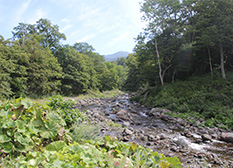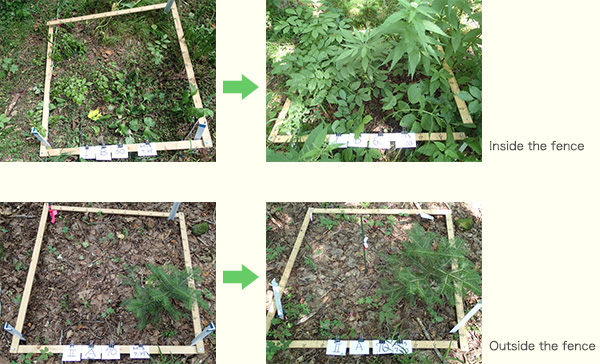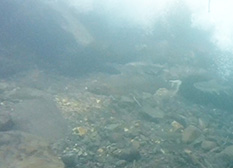Activity Report
Report on Activities from April 2015 to March 2016
Project to Restore Japanese Judas Trees and Life-Giving River
Deer Fence Along the Iwaobetsu River Completed
In order to allow the forest along the Iwaobetsu River to return to its original state, a three-meter-high fence was erected and has proved an effective means of protecting the trees by preventing the Sika deer from eating saplings and young trees. This past year, work crews whose members included Daikin employees and volunteers from all over Japan completed the planned work on the deer fence, erecting a total of 1,200 meters of fence in three locations. For all three sections of fence, there was no major damage and no signs that deer had passed through it. As for the Japanese Judas tree seedlings that had been planted inside the fenced-off area, although a few had died, most have shown healthy growth.
 In fiscal 2015, 150 meters of deer fence was
completed
In fiscal 2015, 150 meters of deer fence was
completed
 Deer Fence Erected Near Iwaobetsu River
Deer Fence Erected Near Iwaobetsu River
 Final section of the deer fence completed
Final section of the deer fence completed Japanese Judas tree saplings are gradually
growing
Japanese Judas tree saplings are gradually
growing Carrying lumber for the fence
Carrying lumber for the fenceVerifying the Effectiveness of Removing Artificial River Banks
In order to promote reforestation along the Iwaobetsu River and return the river to a natural state that is more conducive to habitation by wildlife, riverbanks constructed years ago were removed so that the river could flow freely. In fiscal 2015, surveying work was done and aerial photographs taken at the site where the artificial riverbanks had been removed. Along with this data, analysis was done on changes in the river’s water level.
 The Iwaobetsu River in May.
Melting snow is causing high water levels
The Iwaobetsu River in May.
Melting snow is causing high water levels The same location in August. There
are no major changes, and the river remains in a stable state
The same location in August. There
are no major changes, and the river remains in a stable stateFlora and Fauna Survey Conducted
A survey to verify the effectiveness of the deer fence erected along the Iwaobetsu River revealed that plant life is growing steadily and healthily inside the fenced-off area compared to outside of it.

In 2015, sensor cameras were installed to help determine the frequency of deer appearances outside the fenced-off area.
 Photo shows a deer approaching the
fence
Photo shows a deer approaching the
fence
Regeneration of the riparian forest creates tree shade along the river and helps keep the river at a proper temperature. In addition, the insects that fall from the branches and leaves of the trees are a valuable source of food for the wildlife in the river. A fiscal 2014 survey revealed the existence of two young cherry salmon (a kind of fish that is born in the river and returns to the ocean) and one cherry salmon spawning bed. This was good news, since cherry salmon had once disappeared from the river. And in order to understand the state of the fishes’ habitat, a total of 324 char salt-water trout and Yamame trout were collected and their body length measured.
 Surveying the fishes’ spawning grounds
Surveying the fishes’ spawning grounds A female cherry salmon (in center of
photo)
A female cherry salmon (in center of
photo) We are one step closer to restoring the river to the days when it was teeming with life!
Project to Promote Human-Brown Bear Coexistence in Shiretoko
New Sections of Electric Fence Completed, and All Originally Planned Fences Now in Operation

An electric fence ensures that brown bears do not enter human residential areas between the time that the bears awaken from hibernation in spring until they hibernate once again in early winter.
Up until June, electric fences had been put into operation: a 7-km section between Kikiribetsu and Aidomari, and 1.5 km of fence in two districts on the north side of central Rausu Town. In addition, 0.9 km of electric fence was erected on the south side of central Rausu Town and was put into operation. This means that all originally planned electric fences are now in operation.
 Erecting the electric fence that
winds its way along the coast of Rausu Town. Erecting the fence while standing
on the hillside is physically demanding work
Erecting the electric fence that
winds its way along the coast of Rausu Town. Erecting the fence while standing
on the hillside is physically demanding work
In fiscal 2015, the electric fence has shown to be effective. Brown bears have been seen on the outer side of the fence on the north side of central Rausu Town and appear to be keeping their distance from the electric fence. Sensor cameras have captured images of bears touching the fence and getting an electrical shock. However, the number of brown bear sightings fluctuates from year to year. Therefore, it will be necessary to carry out monitoring over the long term in order to determine the effectiveness of the electric fence.
Surveys Revealed Movement of Brown Bears Just After Awaking from Hibernation, Something Previously Difficult to Determine
In Shiretoko, where humans and brown bears exist in close quarters, despite their acceptance of the bears, humans’ knowledge of how to avoid clashes with the bears is constantly being put to the test. To get along amicably with the bears, humans must first learn about them. We are still in the process of solving numerous riddles one by one. For example, who is a certain bear’s father? Where are the cubs that are separated from their mother going?
By tracking the trajectory of brown bears that have been fitted with GPS devices, we have determined the movement of brown bears immediately after they awaken from hibernation. For example, in 2014 a mother bear with a cub under a year old covered quite a large area in her movements, while in 2015 a mother bear with two newborn cubs hardly moved at all and stayed near the place of hibernation. From the GPS data, it also appears that the size of the area covered by females differs dramatically depending on factors such as whether they have cubs or how old they are.

All field surveys of the five-year plan have been completed, and it is now possible to analyze the genetic data taken from the 712 bears that account for the majority of the individual bears captured in the towns of Shari and Rausu. Thanks to this effort, Shiretoko is one of the few areas in the world with this much information on the blood relations among brown bears.
These survey results will be used to cast light on the habitat of the brown bears so that continually better ways can be found for coexistence between the bears and humans.
Note: The photos on this website are courtesy of the Shiretoko Nature Foundation.








